Climate Change Countermeasures
Basic Approach
Hitachi High-Tech Group is promoting systematic activities to reduce energy-induced and non-energy-induced GHG emissions as a response to climate change. Specifically, we are working to reduce GHG emissions throughout the value chain through continuous promotion of the use of renewable energy, environmental investment, improvement of manufacturing processes, and environmentally conscious design, and we aim to achieve net zero for all domestic and international sites by fiscal 2027, and for the entire value chain by fiscal 2050. As part of this effort, we regularly hold briefings for our procurement partners, where we explain the importance of climate change measures, clarify and request promotion of plans to reduce GHG emissions.
Independent Assurance
In order to enhance the credibility of this report, FY2024 figures marked with ![]() have received independent assurance from SOCOTEC Certification Japan Co., Ltd. in accordance with the International Standard on Assurance Engagements (ISAE) 3000 and ISO14064-3.
have received independent assurance from SOCOTEC Certification Japan Co., Ltd. in accordance with the International Standard on Assurance Engagements (ISAE) 3000 and ISO14064-3.
Initiatives
Toward the Realization of a Decarbonized Society
About 90% of the energy used in our group’s business activities comes from electricity consumption. In order to more efficiently reduce GHG emissions, including at our sites outside Japan, we have assigned top priority to switching over to 100% renewable energy, with the aim of achieving zero GHG emissions by FY2027. We also give due consideration to the perspective of additionality when expanding renewable energy.
Promotion of switching to a decarbonization menu for contracted electric power at sites (Reduction of Scope 2 emissions)
We are promoting the reduction of Scope 2 emissions by switching to renewable energy sources for electricity and leveraging the value of renewable energy. The semiconductor manufacturing equipment production facility "Naka-Marine Site" built in Hitachinaka City, Ibaraki Prefecture, has been using renewable energy and operating as a zero-GHG emission plant since its completion in March 2021. Similarly, at the Hitachi High-Tech Kasado area, another semiconductor manufacturing equipment site, we switched to renewable energy in July 2023. We will continue to use renewable energy from the initial completion at all new sites in the future. In addition, we are promoting the switch to renewable energy at our domestic branches, sales offices, and overseas locations. We will work to further expand the use of renewable energy sources in the future.
Promoting Reduction of Fuel Used at Sites (Scope 1 Emissions Reduction)
The Hitachi High-Tech Group consumes fuel for cargo handling and drying of paints at manufacturing sites, and by commercial vehicle operations. To achieve decarbonization, we are promoting reduction of Scope 1 emissions by electrifying cargo handling equipment, converting company vehicles to EVs, collecting and treating greenhouse gases (non-energy origin) such as SF6 and HFCs (including SF6 used in TEM (Transmission Electron Microscope)), and considering alternatives.
Status of Promotion of Carbon Neutrality
24 locations in Japan and overseas have achieved carbon neutrality through initiatives such as switching to renewable energy power, utilizing renewable energy values and offset credits, and switching to EV vehicles.
We will continue our efforts on a global basis, aiming to achieve carbon neutrality at all Hitachi High-Tech Group sites by FY2027.
Promoting Energy Conservation with Environmental Investment and Process Reforms, and Promoting the Introduction of Internal Carbon Pricing*
Hitachi High-Tech Group established the Environmental Investment Guidelines in FY2016 to improve the ease and efficiency of environmental investment. Since the investments made in FY2017, these guidelines have contributed to the growth of environmental investment and improvement in the reduction effect in the amount of CO2 versus investment. In FY2021, we introduced an Internal Carbon Pricing system (internal carbon price of 14,000 yen/t-CO2) to further promote environmental investment, and began applying the system to investments made in FY2022.
We are also actively working to save energy by streamlining our manufacturing processes.
* Internal Carbon Pricing: A system in which a company places a price on its own carbon emissions in order to quantitatively clarify the impact on current and/or future business activities and to facilitate strategic decision-making, based on the premise that addressing climate change will present both costs and opportunities.
Energy-saving initiatives carried out by FY2024
At the Hitachi High-Tech Group, we have worked to introduce LED floor lighting in offices and communal areas, etc.
In addition, we are replacing transformers and air-conditioning units with highly efficient equipment, and improving manufacturing processes, at our manufacturing sites.
In FY2024, annual GHG emissions were 19,555 tons, compared to a target for energy-induced CO2 of 19,732 tons, and thus, we achieved our target. This achievement was influenced by greater than planned progress in switching over to renewable energy sources for the electric power used as well continuous promotion of environmental investment and other such factors.
Based on these results, we will continue to introduce energy-saving equipment, use energy efficiently, implement renewable energy, and promote energy-saving activities as we aim for carbon neutrality.
Energy-Saving Activities at Business Sites
| Item | Measure |
|---|---|
| Renewable energy | Installation of solar panels on building rooftops (including onsite PPA) |
| Air Conditioning System | Improvement in air conditioner operation mode for clean rooms (Adjustment of the control accuracy for holidays and nighttime, discrete control of cleanliness for each compartment) Installation of controllers of the energy-saving type in air conditioner Installation of air conditioning remote monitoring system Installation of hybrid fans Installation of underfloor air conditioning systems Installation of watering system to exterior unit |
| Air Conditioning and Power utilization efficiency | Less power loss through installation of phase advance capacitors Installation of super-amorphous transformers Installation of automatic power factor regulators Reduce energy consumption of IT infrastructure |
| Various equipment and facilities | Installation of air conditioner compressors controlled by the number of air conditioner units in
operation Installation of inverter-controlled cooling water supply equipment Installation of EV charging stations Periodic replacement of air conditioning equipment, compressors, transformers, and other equipment |
| Lighting | Installation of a system for automatic selection of illuminance Installation of lights for automatic detecting the presence of persons Installation of LED lights Installation of inverter ballasts with luminaires Fewer lights are lit and unnecessary lights are turned off when not needed. |
| Building | Laying double roofs Implementation of thermal barrier coating Replacement with thermal windows |
| Enlightenment activity | Handbills are distributed and signboards are installed in energy-saving months. Cool Biz and Warm Biz “Green” walls on building windows and walls |
In FY2023, annual CO2 emissions were 19,555 tons, compared to a target for energy-induced CO2 of 19,732 tons, and thus, we achieved our target. This achievement was influenced by greater than planned progress in switching over to renewable energy sources for the electric power used as well continuous promotion of environmental investment and other such factors.
Based on these results, we will continue taking initiatives to reduce CO2 emissions to zero and to save energy by installing equipment and facilities of an energy-saving type, by efficiently using energy, and by generating renewable energy.
As part of efforts to create value through environmental initiatives, our group estimated the forest carbon stock in the Fuji Oyama Works of Hitachi High-Tech Analysis (Sunto-county, Shizuoka Prefecture) , which is engaged in biodiversity conservation activities.
Performance Data
Changes in Volume of GHG Emissions in Japan
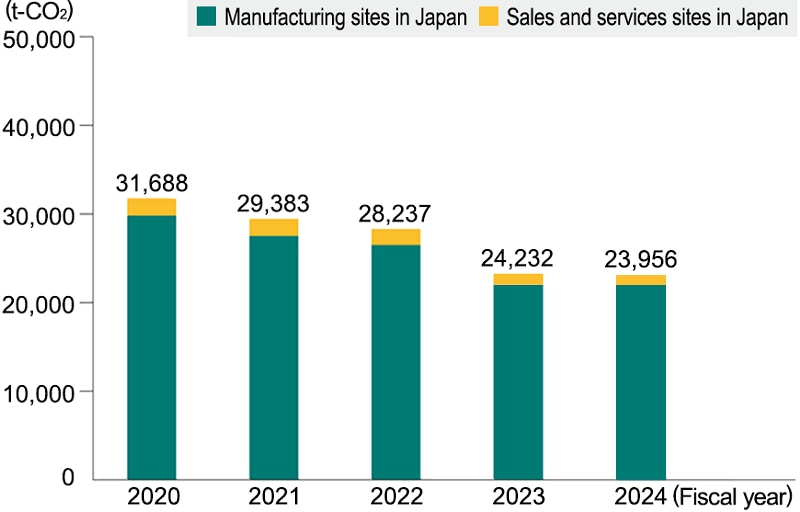
* Reporting boundary:Hitachi High-Tech and group companies in Japan
* Calculation method: Conforms to the Manual for Calculation and Reporting of Greenhouse Gas Emissions (Ministry of the Environment and Ministry of Economy, Trade and Industry) CO2 emissions volume calculated using conversion factors adjusted for power options provided by electric power companies and retail power suppliers.
* The total of energy-induced CO2 and non-energy-induced CO2
Changes in CO2 Emissions per Unit of Revenue in Japan
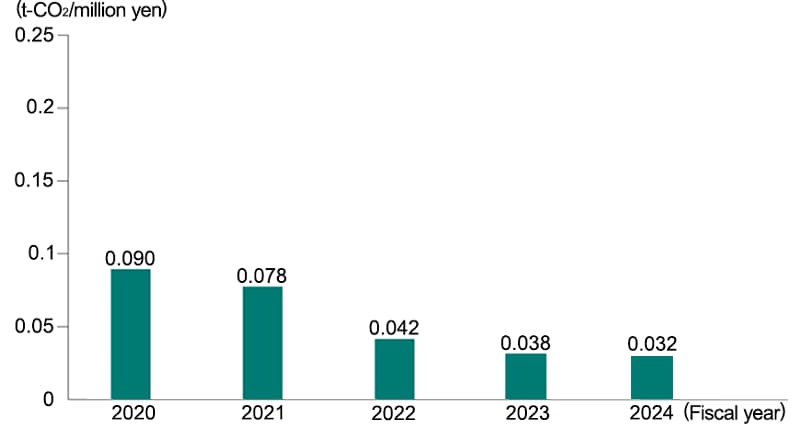
* Reporting boundary: Manufacturing sites of Hitachi High-Tech Corporation Head Office and group manufacturing companies in Japan
* Calculation method: Conforms to the Manual for Calculation and Reporting of Greenhouse Gas Emissions (Ministry of the Environment and Ministry of Economy, Trade and Industry). CO2 emissions volume is the total value for energy-induced Scope 1 and 2 emissions; emissions for electric power are calculated using conversion factors adjusted for power options provided by electric power companies and retail power suppliers.
Changes in Energy Usage (Crude Oil Equivalent)
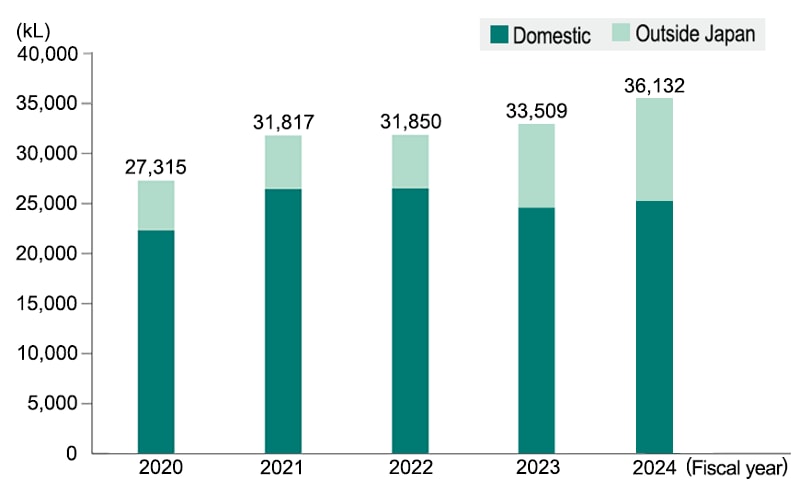
* Reporting boundary: All Hitachi High-Tech Group companies (Excluding Hitachi High-Tech Ireland and Hitachi High-Tech Israel. The figures from FY2018 include Hitachi High-Tech Analysis and excludes Hitachi High-Tech Russia and Hitachi High-Tech Kuwait Office in FY2020.)
* Calculation method: Conforms to the stipulations of the Act on the Rational Use of Energy
Changes in Energy Usage Improvement Rate per Unit of Sales in Japan (Crude Oil Equivalent)
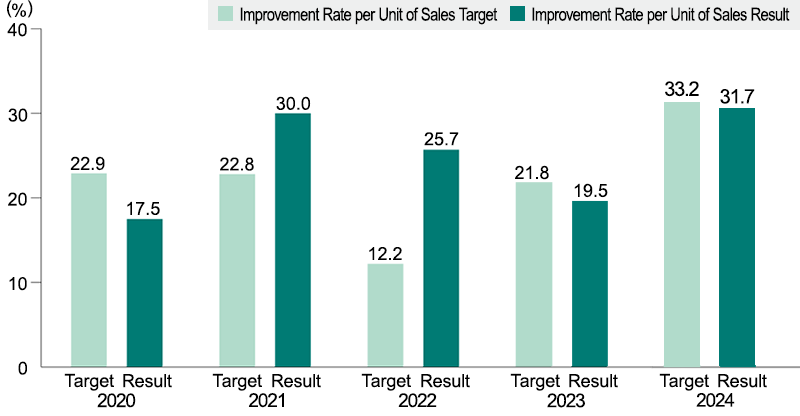
* Reporting boundary: Hitachi High-Tech Group companies in Japan. The Naka-Marine Site has been included since FY2022.
* Calculation method: Conforms to the stipulations of the Act on the Rational Use of Energy
* Energy usage improvement rate per unit: The rate of improvement over the base FY 2010 {(1 - base units of the relevant site for the relevant fiscal year/base units of the relevant site for the base year) x environmental impact at the relevant site for the base year calculated by group companies in Japan}
Changes in Volume of CO2 Emissions Outside Japan
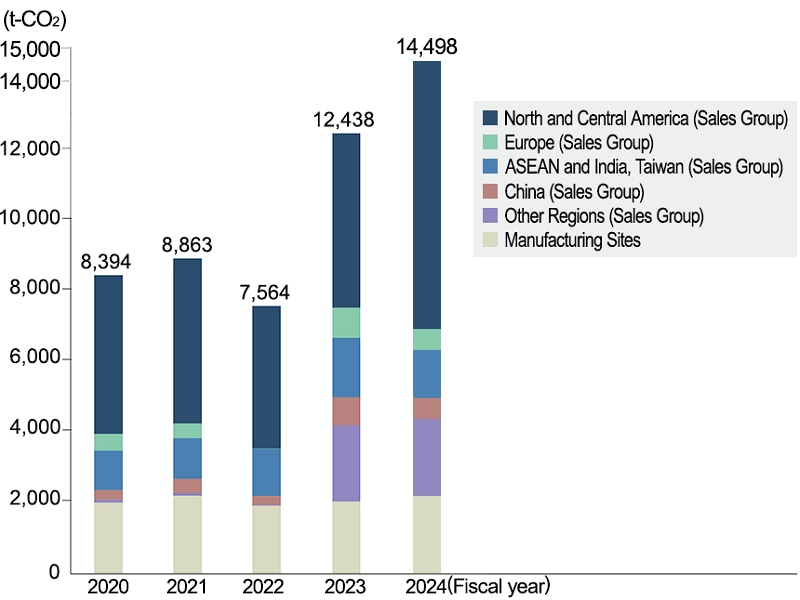
* Reporting boundary: Overseas subsidiaries (excluding Hitachi High-Tech Ireland and Hitachi High-Tech Israel)
* Calculation method: Conforms to the Manual for Calculation and Reporting of Greenhouse Gas Emissions (Ministry of the Environment and Ministry of Economy, Trade and Industry). However, the FY2021 CO2 emission factor for electric power is based on the value published by the IEA (International Energy Agency) in 2021 for 2019. For FY2020, values published by the IEA in 2020 for 2018 were used; For FY2019, values published by the IEA in 2019 for 2017 were used; for FY2018, values published by the IEA in FY2017 for 2015 were used; for FY2017 and earlier, 2005 values published by the IEA in 2010 were used. (If IEA factors for 2017 were used for the calculation of the FY2018 figure, CO2 emissions would have been 10,349 tons.)
Information Disclosure Based on TCFD Recommendations*
We have been instituting measures to support TCFD since we began studies of it in FY2018. We established a working group (the TCFD Study Group) under the Sustainability Promotion Committee in November 2020. The Study Group conducted scenario analysis (identification of specific climate change risks and opportunities, consideration of measures to address them, etc.) for each of the Hitachi High-Tech Group's businesses. We will continue actively promoting specific initiatives for management strategy and risk management addressing climate-related risks, in particular.
We will disclose climate-related information obtained from these efforts in accordance with the TCFD recommendations. In engaging in disclosure as a member of the Hitachi Group, which supported the recommendations by TCFD, we will also coordinate with Hitachi, Ltd., our parent company, in our efforts to achieve substantial disclosure.
* The Task Force on Climate-related Financial Disclosures (TCFD) recommended that corporations and other enterprises disclose information relating to climate change risks, opportunities, and so on.
CDP*1 Evaluation
We have responded to CDP climate change questionnaires at the Hitachi High-Tech Group. In FY2024, we received a score of " Leadership: A" for “best practices in the managing environmental issues” in our businesses for the first time. We were also selected for the second consecutive year as a Supplier Engagement Leader, the highest rating in the Supplier Engagement Rating (SER) assessment performed by CDP. This reflects recognition of our efforts to reduce greenhouse gas emissions throughout our supply chain.
Our Group will work toward improvements in corporate value, while making effective efforts to address climate change risks.
*1 CDP: A UK-based independent non-profit organization. It receives requests from investors around the world, and investigates, evaluates, and discloses information relating to companies’ effects on climate change, water security, and forests.
